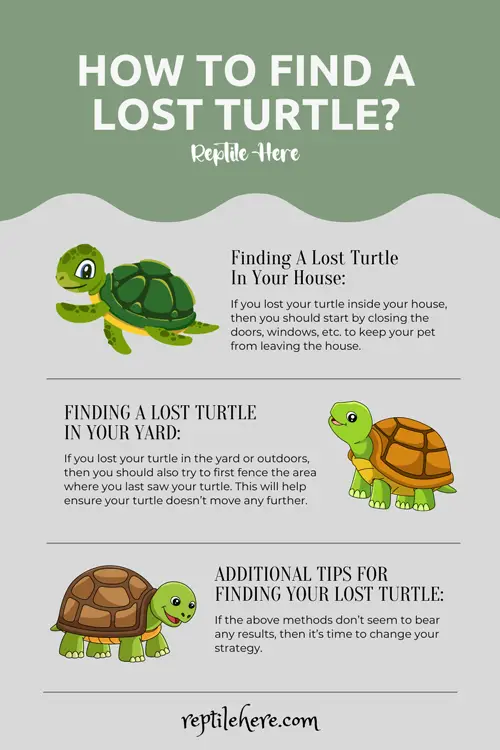Lost Turtle: How To Find A Turtle That Is Lost?
It’s not uncommon for pet turtles to go missing, whether inside the house or in the backyard. However, finding your lost turtle isn’t always easy and you may not even know when to start. Luckily, this guide will help you out.
How to find a turtle that is lost? To find your lost turtle, look for it where you last saw it as turtles don’t move quickly. Possible places your turtle may hide in include dark, quiet, and concealed areas or in tight spots that are hot or warm, e.g. near a hot computer.
This guide shares more helpful info about what to do when your turtle runs away, tips for finding your lost turtle, and more.
How to find a lost turtle?
Contents
When searching for a lost turtle, you should concentrate on the area where you last saw your turtle. This is because turtles generally don’t move fast and also tend to be cautious about where they go.
That said, the process of searching for your lost turtle depends on whether you lost it inside your house or in your yard.

Let’s look at each scenario below:
Finding a lost turtle in your house:
If you lost your turtle inside your house, then you should start by closing the doors, windows, etc. to keep your pet from leaving the house.
Next, search under and behind every furniture, couch, bed, wardrobe, etc. You should also check all the corners of your room.

If you have a flowerpot inside your house, your turtle may also choose to hide there. This is especially true for a female turtle looking for a suitable place to lay her eggs.
If you have hard flooring in your house, you can also listen for your turtle crawling or scratching when trying to get out of a tight spot.
Finding a lost turtle in your yard:
If you lost your turtle in the yard or outdoors, then you should also try to first fence the area where you last saw your turtle. This will help ensure your turtle doesn’t move any further.

You can then go ahead and check all the possible hiding spots in the area, including piles of leaves, piles of rocks, holes, a pool (if you have one), or a vegetable garden.
Additional tips for finding your lost turtle:
If the above methods don’t seem to bear any results, then it’s time to change your strategy.

Below are some helpful tips to help you find your missing turtle:
Ask your neighbors, especially the children since they spend more time outdoors if they have seen your missing turtle.
Check the nearby water bodies, including ponds, streams, pools, etc. Turtles usually get drawn to the waters. If your neighbors have ponds or pools, check them as well.

Make posters with your missing turtle clear picture and distribute them in the surrounding areas to increase the chances of finding your pet turtle.
You can also post about your missing turtle in your local Facebook groups and other social media platforms.
Visit your local wildlife rescue organization to enquire if they have seen your turtle or if they can offer you any assistance in finding it.
How to get a turtle to come out of hiding?
You can pull your little friend out of its hiding by using what it loves most—food!
Turtles particularly love fish or meat such as beef, chicken, port, etc. We recommend using fish as it’s smellier and will pull out the turtle much faster. But if you don’t have fish, you can also use meat.

Cut the meat into pieces and place them throughout the area where you lost your pet turtle.
Step back a few feet so that the area is quiet and your turtle will feel it’s safe to come out. Your turtle will most likely get out of its hiding after a while.
What should you do when you find your lost turtle?
Once you’ve found your missing turtle, the first thing you should do is inspect it for shell cracks and injuries. Check if it has broken bones, cuts, bruises, etc., which it may have incurred if it fell when escaping.
In case you notice any injuries or breeding or suspect your turtle has broken bones, take your pet to the vet immediately!
If your turtle seems alright, just soak it in clean water to help wash away any dust or dirt it may have accumulated while on the run.

Try rehydrating your pet by soaking it in a pedialyte or simply a solution of 50% water and 50% Gatorade, at around 75 to 80 degrees F.
Continue feeding your turtle as you normally do; don’t overfeed it as a way to compensate for the days it went missing.
Above all, put measures in place to prevent your turtle from easily escaping again. This includes putting a secure screen or protective barrier that makes it hard for your pet turtle to escape.
Can a turtle find its way home?
Some species and individual turtles have a homing instinct and will easily find their way home if they get lost. This is clearly shown in this James Cook University study, where up to 59 turtles were re-released from the areas where they have stayed for a long time and their movement was tracked. Surprisingly, all of them got back home except one!

An eastern box turtle is one such turtle known to have a homing instinct and will easily navigate back home if it finds itself in an unfamiliar area. However, it may depend on the individual box turtle’s ability to find its way home.
Final Verdict
Losing your beloved turtle can be a stressful experience, but you can still find it if you know how to go about it. You should start your search where you last saw your turtle as these reptiles move slowly. Check under and behind every possible hiding spot, nearby water bodies, etc. Putting flyers in the area and posting about your missing turtle in your local social media groups can also increase your chances of getting back your pet.


